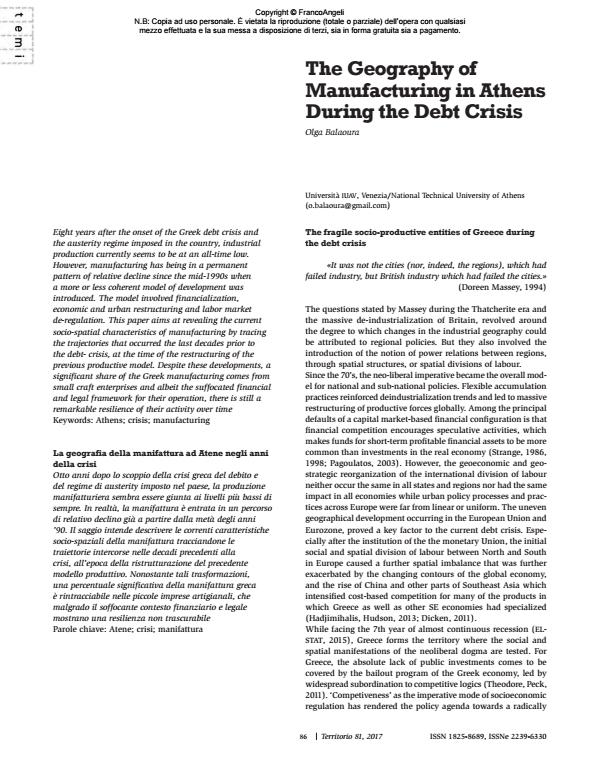The Geography of Manufacturing in Athens During the Debt Crisis
Titolo Rivista TERRITORIO
Autori/Curatori Olga Balaoura
Anno di pubblicazione 2017 Fascicolo 2017/81
Lingua Inglese Numero pagine 6 P. 86-91 Dimensione file 232 KB
DOI 10.3280/TR2017-081020
Il DOI è il codice a barre della proprietà intellettuale: per saperne di più
clicca qui
Qui sotto puoi vedere in anteprima la prima pagina di questo articolo.
Se questo articolo ti interessa, lo puoi acquistare (e scaricare in formato pdf) seguendo le facili indicazioni per acquistare il download credit. Acquista Download Credits per scaricare questo Articolo in formato PDF

FrancoAngeli è membro della Publishers International Linking Association, Inc (PILA)associazione indipendente e non profit per facilitare (attraverso i servizi tecnologici implementati da CrossRef.org) l’accesso degli studiosi ai contenuti digitali nelle pubblicazioni professionali e scientifiche
Eight years after the onset of the Greek debt crisis and the austerity regime imposed in the country, industrial production currently seems to be at an all-time low. However, manufacturing has being in a permanent pattern of relative decline since the mid-1990s when a more or less coherent model of development was introduced. The model involved financialization, economic and urban restructuring and labor market de-regulation. This paper aims at revealing the current socio-spatial characteristics of manufacturing by tracing the trajectories that occurred the last decades prior to the debt- crisis, at the time of the restructuring of the previous productive model. Despite these developments, a significant share of the Greek manufacturing comes from small craft enterprises and albeit the suffocated financial and legal framework for their operation, there is still a remarkable resilience of their activity over time
Otto anni dopo lo scoppio della crisi greca del debito e del regime di austerity imposto nel paese, la produzione manifatturiera sembra essere giunta ai livelli più bassi di sempre. In realtà, la manifattura è entrata in un percorso di relativo declino già a partire dalla metà degli anni ’90. Il saggio intende descrivere le correnti caratteristiche socio-spaziali della manifattura tracciandone le traiettorie intercorse nelle decadi precedenti alla crisi, all’epoca della ristrutturazione del precedente modello produttivo. Nonostante tali trasformazioni, una percentuale significativa della manifattura greca è rintracciabile nelle piccole imprese artigianali, che malgrado il soffocante contesto finanziario e legale mostrano una resilienza non trascurabile
Parole chiave:Atene; crisi; manifattura
- Shaping Dimensions of Urban Complexity: The Role of Economic Structure and Socio-Demographic Local Contexts Luca Salvati, Margherita Carlucci, in Social Indicators Research /2020 pp.263
DOI: 10.1007/s11205-019-02156-2
Olga Balaoura, The Geography of Manufacturing in Athens During the Debt Crisis in "TERRITORIO" 81/2017, pp 86-91, DOI: 10.3280/TR2017-081020